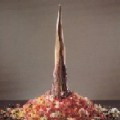 |
 |
 |
 |
 |
Top |
 |
Album |
 |
Web Exhibition |
 |
Studio |
 |
Miscellaneous |
 |
Biography |
 |
Link |
 |
Contact |
|
|
At a festival of the famous Monkey Temple this practice was at an even grander scale, with believers throwing volumes of flowers at a huge linga like a big wind. The layers of old flowers were already beginning to rot and turn into a compost state. Although Benares is well known for believers dipping into the Ganges or the deceased being burned in a ceremony along the river, the sight of piles of flowers around the holy linga impressed me as an ikebana artist. The practice of chopping flowers off at the top seemed cruel and murderous so I asked a guide about this custom of cutting flowers off at the neck to throw at linga. He explained to me that by cutting flowers at the top and leaving the stems and roots, this would allow the plants to regenerate and thus fulfill a Hindu belief in rebirth. This philosophy of regeneration impressed me immensely. This experience forced me to reconsider the meaning of ikebana. From the plane, Japan is verdant but India and China are brown and I wondered if ikebana could be appreciated just anywhere in the world.
Old mandala is exquisite and filled with the drama of life. Then one day while creating a rikka arrangement I realized that rikka is of the same essence as a mandala. As the background history of rikka is steeped in Shintoism, Buddhism, and Confucianism, it is only natural to think that the influence of mandala is also present. Each time I am able to successfully arrange rikka I feel my spirit is in a mandala. When I visit Nepal as well I feel like I am in a mandala. For young people who might be at a trying time in their lives, practicing rikka can give a sense of order and balance. Even though I don't formally believe in the Gods of India and Nepal I can feel a sense of spiritualism in my life and work from their images. |
| BACK |

